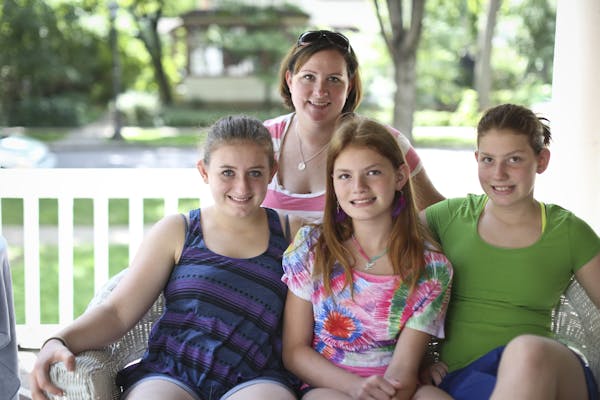If you had asked Christian Prado Diaz a year ago about his favorite foods, the preschooler would have listed some greasy delight from Wendy's, where his mother works the drive-through lane.
Today? "Arroz!" the 4-year-old proclaimed. It's Spanish for rice.
" … y brócoli!"
As public health officials analyze new data showing a turnabout decline in obesity among low-income children in Minnesota, few tales are as illustrative as Christian's transformation from French-fry guy to green veggie guru. It took a mother's motivation to ditch her family's habits, a weekly program to teach the value of nutrition and exercise, and finally a purge of unhealthy snacks from the pantry and refrigerator that outlasted weeks of Christian's whining.
"Changes are really hard," said Dr. Julie Boman, a pediatrician at Children's Hospitals and Clinics of Minnesota. "But for younger kids, if their parents are motivated, they can do a lot."
The share of low-income preschoolers in Minnesota who are obese declined from 13.4 percent in 2008 to 12.6 percent in 2011, according to a much-anticipated report released last week by the U.S. Centers for Disease Control and Prevention. Minnesota was one of 19 states or U.S. territories to show such progress, after two decades of rising national obesity rates.
Experts believe the decline reflects public health efforts — such as the program that served the Diaz family — which have caught up with the desire in many families to adopt healthier lives.
Minnesota has invested millions of dollars since 2009 in community health improvement efforts — from "walking bus" and healthy snack programs in schools, to recreational trails and bike paths. Blue Cross and Blue Shield of Minnesota has sponsored ads that use a touch of shame to motivate parents to fight childhood obesity. Hospitals have increased promotion of breast-feeding, in part because research links it to lower rates of childhood obesity.
Research hasn't proven that Minnesota's projects — such as farmers markets in low-income neighborhoods lacking affordable produce — have directly caused weight loss.
But research has shown both a "trickle down" and a "trickle up" effect in the ability of such programs to change behavior, said Dr. Ed Ehlinger, Minnesota health commissioner. Programs to improve the diets of children affect their parents. Programs to change the habits of parents pay dividends for their children.
"I can't say that a farmers market is going to reduce weight in a community by a pound per person," Ehlinger said. "But we do know that all of our efforts are improving the quality of food in communities, in schools, in child-care centers. And we're increasing physical activity among kids and adults. Those efforts are leading to major changes in personal behaviors."
Mustard yes, lard no
For Diaz's mother, Christina, the motivation came from a visit to the pediatrician and the news that her son was clinically obese.
"I want the best for my son," she said through an interpreter. "I don't want him to end up with diabetes [or other chronic diseases]. Then I'd be asking myself, 'Why didn't I do something?' "
But she didn't know how until she started participating in Vida Sana, a grant-funded program created last summer by Children's Hospital and other community groups to give Hispanic families nutritional information and exercise opportunities. An initial group of parents chose the name — Spanish for healthy living — and the Latino dance activity Zumba as the exercise option, said Boman, who helped create the program.
The weekly sessions taught Diaz how to use nutritional labels, that drinking more water would produce immediate benefits, and how ingredients such as mustard could boost the flavor in cooking without adding fat and calories. Having grown up in Mexico City — with a diet that included tamales cooked in lard and other fried foods — Diaz said this was all new information to her.
It took two weeks for Christian to stop begging for unhealthy snacks once his mother removed them from the kitchen of their Richfield home. She also removed junk food from her sister's home — where Christian and his younger sister go for day care — and started substituting healthy foods.
"If you don't buy it, you don't have it around the house, they don't see it and they're not going to ask for it," she said. "So now they don't ask for it."
The family loves to dance and chase each other around, but to increase exercise, Christian's parents bought him a bike to ride in the neighborhood.
"Es grande," Christian shouted proudly about his bike.
More Zumba
Boman said there are many anecdotal examples such as the Diaz family to indicate that Vida Sana is working. Diaz, she said, "is learning in Spanish, from people she trusts."
Attendance in the program has remained strong after one year and parents are asking for additional Zumba sessions.
Boman will be gathering data on the program's effectiveness and presenting it this fall at the annual conference of the American Academy of Pediatrics. The program is funded for only three years, but she hopes to work with the other partners — HealthPartners and the Pillsbury United Communities Waite House — to keep it going.
Diaz said she feels healthier and her son has lost significant weight, which has led to other changes. "He doesn't get winded as much," she said. "He was starting to get asthmatic because of his weight."
And, she added, he no longer snores at night, "like an old man."
Jeremy Olson • 612-673-7744

Minnesota Sports Hall of Fame: A class-by-class list of all members

This retired journalist changed professional wrestling from Mankato

